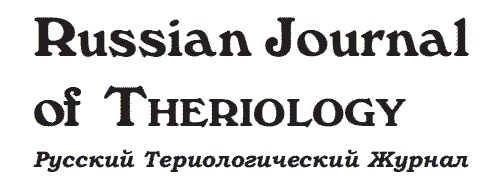New subspecies of the common long-eared bat Plecotus auritus (Vespertilionidae: Chiroptera) from the Caucasus
Kruskop S.V., Zhukova S.S.
P. 1-8
Comparison of the mtDNA sequences and skull measurements indicates the presence of a specific form of Plecotus auritus in the Caucasian part of the species range, which we describe here as a separate subspecies P. a. ponticus subsp. nov. It differs from other long-eared bats from European Russia by having smaller mean values for 13 of 27 measured cranial characters and approximately 4.9% differences in the cytb mitochondrial gene sequence. The described subspecies inhabits the forests of the Caucasus region, as well as, apparently, the northeast of Turkey, and possibly the Rostov region and Crimea. The possibility of identifying other subspecific forms within this wide-range species and the need to study this issue are discussed.
DOI: 10.15298/rusjtheriol.24.1.01References- Ancillotto L. & Russo D. 2023. Brown long-eared bat Plecotus auritus (Linnaeus, 1758) // Russo D. (ed.). Handbook of the Mammals of Europe. Cham: Springer Nature Switzerland AG. P.617–634. DOI: 10.1007/978-3-319-65038-8_72-1.
- Artyushin I.V., Red’kin Ya.A., Kawai K. & Kruskop S.V. 2021. First record of the long-eared bat (Plecotus; Chiroptera: Vespertilionidae) on Urup Island highlights the obscure taxonomic problem // Mammal Study. Vol.46. No.1. P.33–40. DOI: 10.3106/ms2020-0070.
- Benda P., Kiefer A., Hanák V. & Veith M. 2004. Systematic status of African populations of long-eared bats, genus Plecotus (Mammalia: Chiroptera) // Folia Zoologica. Vol.53. Monogr.1. P.1–47.
- Bogdanowicz W., Kasper S. & Owen R.D. 1998. Phylogeny of Plecotine bats: reevaluation of morphological and chromosomal data // Journal of Mammalogy. Vol.79. No.1. P.78–90. DOI: 10.2307/1382843.
- Burland T.M., Barratt E.M., Beaumont M.A. & Racey P.A. 1999. Population genetic structure and gene flow in a gleaning bat, Plecotus auritus // Proceedings of the Royal Society. Vol.266B. P.975–980. DOI: 10.1098/rspb.1999.0732.
- Çoraman E., Furman A., Karataş A. & Bilgin R. 2013. Phylogeographic analysis of Anatolian bats highlights the importance of the region for preserving the chiropteran mitochondrial genetic diversity in the Western Palaearctic // Conservation Genetics. Vol.14. P.1205–1216. DOI: 10.1007/s10592-013-0509-4.
- Juste J., Ibáñez C., Muñoz J., Trujillo D., Benda P., Karataş A., & Ruedi M. 2004. Mitochondrial phylogeography of the long-eared bats (Plecotus) in the Mediterranean Palaearctic and Atlantic islands // Molecular Phylogenetics and Evolution. Vol.31. P.1114–1126. DOI: 10.1016/j.ympev.2003.10.005.
- Hanák V. 1966. Zur Systematik und Verbreitung der Gattung Plecotus Geoffroy, 1818 (Mammalia, Chiroptera) // Lynx (S.N.). Vol.6. P.57–66.
- Hutterer R., Ivanova T., Meyer-Cords C. & Rodrigues L. 2005. Bat Migrations in Europe: a Review of Banding Data and Literature. Bonn: German Agency for Nature Conservation. 162 p.
- Kalyaanamoorthy S., Minh B.Q., Wong T.K.F., von Haeseler A. & Jermiin L.S. 2017. ModelFinder: fast model selection for accurate phylogenetic estimates // Nature Methods. Vol.14. No.6. P.587–589. DOI: 10.1038/nmeth.4285.
- Koopman K.F. 1994. Chiroptera: Systematics. Handbuch der Zoologie. Band VIII, Mammalia, Teilband 60. Berlin & New York: Walter de Gruyter. 217 p.
- Kruskop S.V., Borisenko A.V., Ivanova N.V., Lim B.K. & Eger J.L. 2012. Genetic diversity of northeastern Palaearctic bats as revealed by DNA barcodes // Acta Chiropterologica. Vol.14. No.1. P.1–14. DOI: 10.3161/150811012X654222.
- Kumar S., Stecher G., Li M., Knyaz C. & Tamura K. 2018. MEGA X: molecular evolutionary genetics analysis across computing platforms // Molecular Biology and Evolution. Vol.35. P.1547–1549. DOI: 10.1093/molbev/msy096.
- Kuzyakin A.P. 1950. [Bats]. Moscow: Sovetskaya Nauka. 443 p. [in Russian].
- Mayer F., Dietz C. & Kiefer A. 2007. Molecular species identification boosts bat diversity // Frontiers in Zoology. Vol.4. No.4. DOI: 10.1186/1742-9994-4-4.
- Nguyen L.T., Schmidt H.A., von Haeseler A. & Minh B.Q. 2015. IQ-TREE: a fast and effective stochastic algorithm for estimating maximum likelihood phylogenies // Molecular Biology and Evolution. Vol.32. P.268–274. DOI: 10.1093/molbev/msu300.
- Paz O., de 1994. Systematic position of Plecotus (Geoffroy, 1818) from the Iberian Peninsula (Mammalia: Chiroptera) // Mammalia. Vol.58. P.423–432.
- Ronquist F. & Huelsenbeck J.P. 2003. MrBayes 3: Bayesian phylogenetic inference under mixed models // Bioinformatics. Vol.19. P.1572–1574. DOI: 10.1093/bioinformatics/btg180.
- Russo D. & Cistrone L. 2023. Plecotus auritus. The IUCN Red List of Threatened Species. P.T85535522A211015413. DOI: 10.2305/IUCN.UK.2023-1.RLTS.T85535522A211015413.en.
- Sambrook J., Fritsch E.F. & Maniatis T. 1989. Molecular cloning: a laboratory manual, 2nd ed. New York: Cold Spring Harbor Laboratory Press. 1546 p.
- Santos H., Juste J., Ibáñez C., Palmeirim J.M., Godinho R., Amorim F., Alves P., Costa H., de Paz O., Pérez-Suarez G., Martínez-Alos S., Jones G. & Rebelo H. 2014. Influences of ecology and biogeography on shaping the distributions of cryptic species: three bat tales in Iberia // Biological Journal of the Linnean Society. Vol.112. No.1. P.150–162. DOI: 10.1111/bij.12247.
- Shpak A.V., Kheidorova E.E., Larchanka A.I., Nikiforov M.E., Ghazaryan A., Papov G. & Demianchyk V.V. 2020. [Cryptic Chiroptera species complex Plecotus auritus/austriacus in Belarus: species identification and phylogeographic patterns] // Molecular and Applicative Genetics. Vol.29. P.59–69 [in Russian].
- Strelkov P.P. 1988. [Brown (Plecotus auritus) and gray (P. austriacus) long-eared bats (Chiroptera, Vespertilionidae) in the USSR. Communication 1] // Zoologicheskii Zhurnal. Vol.67. P.90–101 [in Russian].
- Strelkov P.P. 2006. [The crisis of the polytypic species concept as illustrated by the genus Plecotus] // Plecotus et al. Vol.9. P.3–7 [in Russian].
- Spitzenberger F., Strelkov P.P., Winkler H. & Haring E. 2006. A preliminary revision of the genus Plecotus (Chiroptera, Vespertilionidae) based on genetic and morphological results // Zoologica Scripta. Vol.35. No.3. P.187–230. DOI: 10.1111/j.1463-6409.2006.00224.x.
- Tamura K., Stecher G. & Kumar S. 2021. MEGA11: Molecular Evolutionary Genetics Analysis version 11 // Molecular Biology and Evolution. Vol.38. No.7. P.3022–3027. DOI: 10.1093/molbev/msab120.
- Tate G.H.H. 1942. Results of the Archbold expeditions. No. 47. Review of the vespertilionine bats, with special attention to genera and species of the Archbold collections // Bulletin of the American Museum of Natural History. Vol.80. No.7. P.221–297.
Download PDF
|

